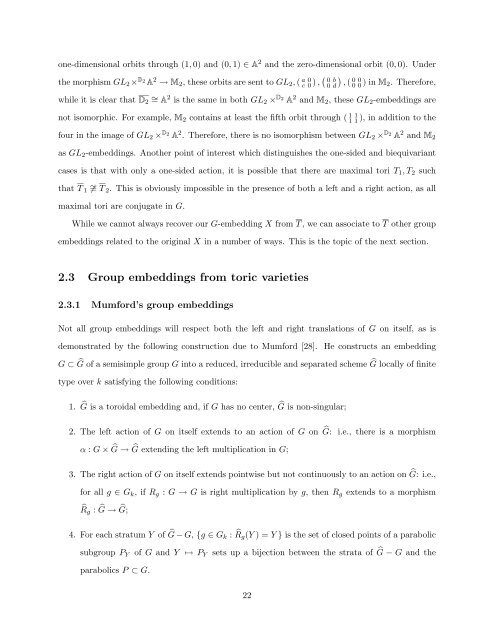Equivariant Embeddings of Algebraic Groups
Equivariant Embeddings of Algebraic Groups
Equivariant Embeddings of Algebraic Groups
You also want an ePaper? Increase the reach of your titles
YUMPU automatically turns print PDFs into web optimized ePapers that Google loves.
one-dimensional orbits through (1, 0) and (0, 1) ∈ A 2 and the zero-dimensional orbit (0, 0). Under<br />
the morphism GL 2 × D 2<br />
A 2 → M 2 , these orbits are sent to GL 2 , ( a c 0<br />
0 ) , ( )<br />
0 b<br />
0 d , (<br />
0 0<br />
0 0 ) in M 2. Therefore,<br />
while it is clear that D 2<br />
∼ = A 2 is the same in both GL 2 × D 2<br />
A 2 and M 2 , these GL 2 -embeddings are<br />
not isomorphic. For example, M 2 contains at least the fifth orbit through ( 1 1 1<br />
1<br />
), in addition to the<br />
four in the image <strong>of</strong> GL 2 × D 2<br />
A 2 . Therefore, there is no isomorphism between GL 2 × D 2<br />
A 2 and M 2<br />
as GL 2 -embeddings. Another point <strong>of</strong> interest which distinguishes the one-sided and biequivariant<br />
cases is that with only a one-sided action, it is possible that there are maximal tori T 1 , T 2 such<br />
that T 1<br />
≁ = T 2 . This is obviously impossible in the presence <strong>of</strong> both a left and a right action, as all<br />
maximal tori are conjugate in G.<br />
While we cannot always recover our G-embedding X from T , we can associate to T other group<br />
embeddings related to the original X in a number <strong>of</strong> ways. This is the topic <strong>of</strong> the next section.<br />
2.3 Group embeddings from toric varieties<br />
2.3.1 Mumford’s group embeddings<br />
Not all group embeddings will respect both the left and right translations <strong>of</strong> G on itself, as is<br />
demonstrated by the following construction due to Mumford [28]. He constructs an embedding<br />
G ⊂ Ĝ <strong>of</strong> a semisimple group G into a reduced, irreducible and separated scheme Ĝ locally <strong>of</strong> finite<br />
type over k satisfying the following conditions:<br />
1. Ĝ is a toroidal embedding and, if G has no center, Ĝ is non-singular;<br />
2. The left action <strong>of</strong> G on itself extends to an action <strong>of</strong> G on<br />
Ĝ: i.e., there is a morphism<br />
α : G × Ĝ → Ĝ extending the left multiplication in G;<br />
3. The right action <strong>of</strong> G on itself extends pointwise but not continuously to an action on Ĝ: i.e.,<br />
for all g ∈ G k , if R g : G → G is right multiplication by g, then R g extends to a morphism<br />
̂R g : Ĝ → Ĝ;<br />
4. For each stratum Y <strong>of</strong> Ĝ − G, {g ∈ G k : ̂R g (Y ) = Y } is the set <strong>of</strong> closed points <strong>of</strong> a parabolic<br />
subgroup P Y <strong>of</strong> G and Y ↦→ P Y sets up a bijection between the strata <strong>of</strong> Ĝ − G and the<br />
parabolics P ⊂ G.<br />
22
















